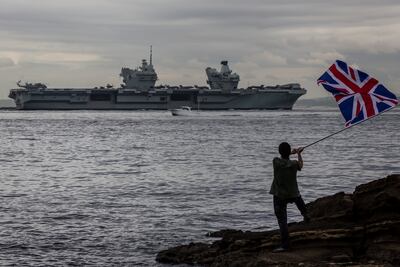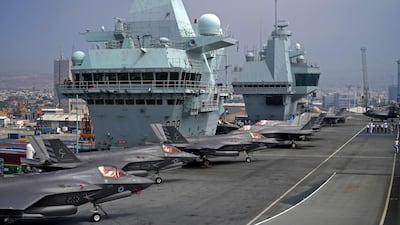Britain is racing to find the wreckage of a Royal Navy F-35 jet which crashed in international waters amid fears that Turkey will seek to salvage highly classified fragments of the aircraft, defence analysts have told The National.
The skin of the £100m jet would be considered a huge prize as it could allow rivals to replicate its stealth capabilities, or give them an increased ability to shoot them down.
British and Nato warships are assembling to protect the Eastern Mediterranean crash site after the advanced fighter went down as it took off from the flagship aircraft carrier HMS Queen Elizabeth on Wednesday.
UK officials said the Ministry of Defence was moving swiftly to recover the fighter.
It is the first time that an F-35 has come down in accessible international waters. The pilot safely ejected and was returned to the ship.
As well as Turkey, Russia is understood to be keen to scour the sea, with even a fragment of the aircraft’s outer skin considered extremely useful.
The latest naval tracking data shows a considerable amount of warship activity south of Crete, with a British Type-45 destroyer on station alongside a specialist tug.

Warships from Spain and Germany are also in the area, and a Norwegian construction support vessel is heading into the waters that could potentially be used to lift the 15-tonne aircraft.
The HMS Queen Elizabeth aircraft carrier is near Sicily, 900km away.
Defence sources have indicated that Turkey is “extremely keen” to find parts, particularly after the US denied sales of the fighter jet to Ankara. Any technology recovered could be used by Turkey’s burgeoning defence industry to develop its own advanced aircraft.
“Turkey has been excluded from the F-35 programme, so I'm sure they’d love to have some debris for their own domestic aerospace industry,” said Gareth Jennings, aviation editor for Janes Defence Weekly. “I'm also sure they would love to find out some of the technical secrets of the F-35. Both the British government and the Americans will be very keen that this aircraft is recovered.”
The UK MoD is understood to be worried about the Russians, who have a naval base in Tartus, Syria, more than a day’s sail away. There is also a possibility that civilian ships could recover debris and sell it on to foreign powers, including China.
“This is a concern,” said a military source. “The Lightnings [F-35s] have modern electronic scanned array radar, an electro-optical sensor and night vision equipment. If you can discover how that works you can work out how close the jet has to come to its target to see things.”
He added that the aircraft’s flight recorders would reveal highly classified performance information on the F-35. “There's plenty of actors in that region who would love to get their hands on this aircraft.”
The military will be hoping that measures introduced to protect the F-35 from reverse engineering -because it was always intended as an export product — will be enough to prevent its secrets being revealed.
But even a scrap of it could prove useful, according to Dr Justin Bronk, air power expert at the Royal United Services Institute (Rusi) think tank.
“One of the big innovations on F-35 is its radar absorbing protein which is very resilient and is a huge advance,” he said. “They will also want to recover the hardware in terms of sensors, radar, emitters, targeting system and lenses.

“I'm sure Russia would love to get its hand on this. The US and British will certainly be keen to get the crash area secured and the recovery done as soon as they can. If they can't raise it, then they’ll probably destroy it in place.”
Tim Ripley, another aviation expert from Janes, said small paint samples from the aircraft skins would allow scientists to find out what the composites are made from. “Once they have those, then they can test their own systems against those systems to find out how better to detect the aircraft,” he said.
The British astute hunter-killer submarine accompanying the carrier, and any American or other Nato submarines in the vicinity, are also likely to head to the site to protect the fighter. The Russians have submarines stationed at Tartus.
The waters south of Crete are about 2,000 metres deep, putting them beyond divers, but easily within range of the US Navy’s deep submergence vehicles that can go to 6,000m.
The recovery effort is likely to take weeks and could be hampered by poor weather.
The Navy will want to establish the cause of the crash of the £100 million ($134.5m) aircraft. Taking off from an aircraft carrier is always challenging, with engine failure the likely cause, either because of a technical problem, bird strike or pilot error.
It is the third time a F-35 has crashed in the last three years.


